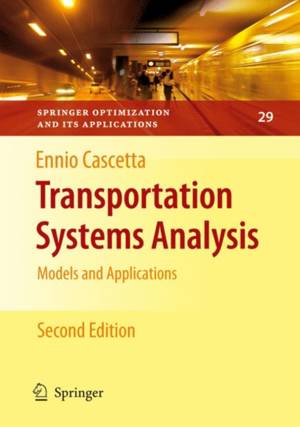
- Afhalen na 1 uur in een winkel met voorraad
- Gratis thuislevering in België vanaf € 30
- Ruim aanbod met 7 miljoen producten
- Afhalen na 1 uur in een winkel met voorraad
- Gratis thuislevering in België vanaf € 30
- Ruim aanbod met 7 miljoen producten
Zoeken
€ 223,95
+ 447 punten
Uitvoering
Omschrijving
Science is made of facts just as a house is made of bricks, but a collection of facts is no more science than a pile of bricks is a house. Henri Poincaré Theaimofthedisciplinesofpraxisisnottheoreticalknowledge. . . . Itistochangetheforms ofaction. . . . Aristotle Transportation systems consist not only of the physical and organizational e- ments that interact with each other to produce transportation opportunities, but also of the demand that takes advantage of such opportunities to travel from one place to another. This travel demand, in turn, is the result of interactions among the v- ious economic and social activities located in a given area. Mathematical models of transportation systems represent, for a real or hypothetical transportation s- tem, the demand ?ows, the functioning of the physical and organizational elements, the interactions between them, and their effects on the external world. Mathematical models and the methods involved in their application to real, large-scale systems are thus fundamental tools for evaluating and/or designing actions affecting the ph- ical elements (e. g., a new railway) and/or organizational components (e. g., a new timetable) of transportation systems. This book discusses the mathematical models that are used to analyze transpor- tion systems, presenting them as the result of a limited number of general assu- tions (theory). It also deals with the methods needed to make these models ope- tional, and with their application to transportation system project design and eva- ation. This ?eld of knowledge is known as transportation systems engineering.
Specificaties
Betrokkenen
- Auteur(s):
- Uitgeverij:
Inhoud
- Aantal bladzijden:
- 742
- Taal:
- Engels
- Reeks:
- Reeksnummer:
- nr. 29
Eigenschappen
- Productcode (EAN):
- 9780387758565
- Verschijningsdatum:
- 15/09/2009
- Uitvoering:
- Hardcover
- Formaat:
- Genaaid
- Afmetingen:
- 156 mm x 234 mm
- Gewicht:
- 1233 g

Alleen bij Standaard Boekhandel
+ 447 punten op je klantenkaart van Standaard Boekhandel
Beoordelingen
We publiceren alleen reviews die voldoen aan de voorwaarden voor reviews. Bekijk onze voorwaarden voor reviews.








